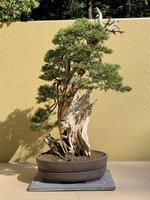Deep Sea Diver
Imperial Masterpiece
I remain uncertain of what the point of all this is. To make a simple breakdown for beginners in bonsai? To talk about bonsai culture in terms of "sustainability"? To try to apply knowledge and practice if horticulture in general to bonsai?
Circling back, one has to refer to the thread stating the original intent… What are the best ways to create sustainable conditions in which bonsai trees will thrive?
This is what I proposed to explore. It’s hard. Maybe fruitless, yet not imho.
In fact many folks believe simply by the nature of keeping a bonsai alive year after year their tree is “sustainable”. ….and this is an interesting point. But the idea is we use our experience to drill down on this topic and see if there are old/new practices that perhaps might not be neglected, or better done to create robust and resilient trees.
So the thought of “trying to think holistically about plants and ecology and try to see how that could apply to growing plants, for our purposes, in small pots” is valid.
Yet threads are for discussions with others, not for the Lone Ranger, merely posting thoughts and ideas as targets for passers by.
I’m looking for other thoughts and ideas that might apply… and will be revisiting this thread/concept, posting occassionally while continuing to think, experiment, work and learn on trees. (btw Here’s a cool tree below we spent the afternoon pruning back last week)
So your ideas and thoughts to move the discussion forward will always be welcome.

cheers
DSD sends


